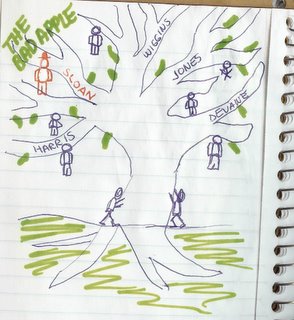Visualizing what we read and hear
Last night, I settled into a rerun of Law and Order. If you’re not a regular of this show, please consider this – it is perhaps the master of using metaphorical one-liners to hammer a point home. Last night was a stellar example. Halfway into the show, the Assistant D.A. was debating innocence and guilt with opposing counsel. At one point, the defense attorney suggested that the prosecutor was trying too hard to pin a rape and murder on a parent or sibling. His comment:
“Are you going to keep shaking the family tree until a pervert falls out?”
This statement immediately spawned a visual in my mind, albeit a bizarre and mildly unsettling one, and one unlikely to have direct business relevance. The immediate relevance, though, is secondary to the importance of letting your mind translate what it reads and hears into what it can see. Let your mind’s eye explore the image created by a comment; you can connect the dots of broader applications later on.
Whenever I experience one of these moments, where a character says something visually provocative, I write notes in a book I keep close at hand for this purpose. I record who made the comment, and in what context. In some instances, I’ll even quickly doodle out the picture that comes to mind, without any concern for quality. The key is to preserve the thought. For example:

As anal retentive as all of this sounds, this book becomes an invaluable reference whenever I’m struggling to come up with a thought. Even if the specific metaphor is not appropriate for my present need, the simple act of starting up the metaphor machine seems to get the juices flowing. Here are other notes in my book:
From Law & Order – the D.A. challenges the suggestion that the prosecution keep mum with the media on a high-profile case: “No comment? Are you trying to chum the waters?”
From Life is Sweet – a mother reacts to a daughter’s assertion that she’s entirely unloved: “Well, that’s a bit sweeping, isn’t it?”
From Frasier – speaking to a colleague about sharing some implement the other had used: “Not if you skipped it to me across a pool of disinfectant.”
From The 40 Year Old Virgin – a daughter’s keening over her mother’s rules gets on the star’s nerves: “She sounds like a teakettle.”
Practicing this technique will not only help you come up with good visual metaphors to use in communication, it will also help you think about the captions that accompany those graphics. Imagine how powerful your communications will be if you reinforce the visual messages with very active, creative words.
If you’re interested in this concept, try a Google search using the keywords, “visual words”. Some very interesting material emerges. For example, Medical News Today carries a story that talks about how visual words can influence perception of smells. Research suggests pleasant words influence olfactory regions of the brain to perceive odors as pleasant. In one example they share, subjects were exposed to the smell of cheddar cheese at the same time as being shown signs that said first “cheddar cheese” and then “body odor.” They found that people had a more positive impression of the smell with the former sign than with the latter. Go figure.
More on sources of creative inspiration in future posts; in the meantime, keep your mind's eye open.


0 Comments:
Post a Comment
<< Home